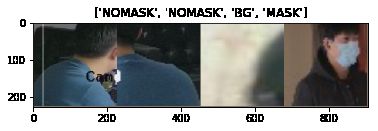pytorch学习笔记 --- 口罩识别的模型训练及应用2
本次实践中,将选一种图像分类的模型,通过重新训练,获得新的模型,数据集使用我们的原来的口罩检测的数据集,打算从头训练出一个识别是否佩戴口罩的模型.
考虑到模型的精度和速度,选择resnet18模型.
数据集分为: train和val 类别为: BG -> 背景 MASK -> 佩戴口罩 NOMASK -> 未佩戴口罩
%matplotlib inline
# 引入必要的库
from __future__ import print_function, division
import torch
import torch.nn as nn
import torch.optim as optim
from torch.optim import lr_scheduler
import numpy as np
import torchvision
from torchvision import datasets, models, transforms
import matplotlib.pyplot as plt
import time
import os
import copy
plt.ion() # interactive mode
# 加载数据集
data_transforms = {
'train': transforms.Compose([
transforms.RandomResizedCrop(224),
transforms.RandomHorizontalFlip(),
transforms.ToTensor(),
transforms.Normalize([0.485, 0.456, 0.406], [0.229, 0.224, 0.225])
]),
'val': transforms.Compose([
transforms.Resize(256),
transforms.CenterCrop(224),
transforms.ToTensor(),
transforms.Normalize([0.485, 0.456, 0.406], [0.229, 0.224, 0.225])
]),
}
data_dir = 'data/mask'
image_datasets = {x: datasets.ImageFolder(os.path.join(data_dir, x),
data_transforms[x])
for x in ['train', 'val']}
dataloaders = {x: torch.utils.data.DataLoader(image_datasets[x], batch_size=4,
shuffle=True, num_workers=4)
for x in ['train', 'val']}
dataset_sizes = {x: len(image_datasets[x]) for x in ['train', 'val']}
class_names = image_datasets['train'].classes
device = torch.device("cuda:0" if torch.cuda.is_available() else "cpu")
print(image_datasets['train'][0])
print(class_names)
(tensor([[[ 0.1768, 0.1768, 0.1768, ..., 0.3138, 0.3138, 0.3138],
[ 0.1768, 0.1768, 0.1768, ..., 0.3138, 0.3138, 0.3138],
[ 0.1768, 0.1768, 0.1768, ..., 0.3138, 0.3138, 0.3138],
...,
[-0.7479, -0.7479, -0.7479, ..., 0.7077, 0.7077, 0.7077],
[-0.7479, -0.7479, -0.7479, ..., 0.7077, 0.7077, 0.7077],
[-0.7479, -0.7479, -0.7479, ..., 0.7077, 0.7077, 0.7077]],
[[ 0.2577, 0.2577, 0.2577, ..., 0.3277, 0.3277, 0.3277],
[ 0.2577, 0.2577, 0.2577, ..., 0.3277, 0.3277, 0.3277],
[ 0.2577, 0.2577, 0.2577, ..., 0.3277, 0.3277, 0.3277],
...,
[-0.6001, -0.6001, -0.6001, ..., 0.9230, 0.9230, 0.9230],
[-0.6001, -0.6001, -0.6001, ..., 0.9230, 0.9230, 0.9230],
[-0.6001, -0.6001, -0.6001, ..., 0.9230, 0.9230, 0.9230]],
[[ 0.2173, 0.2173, 0.2173, ..., 0.2696, 0.2696, 0.2696],
[ 0.2173, 0.2173, 0.2173, ..., 0.2696, 0.2696, 0.2696],
[ 0.2173, 0.2173, 0.2173, ..., 0.2696, 0.2696, 0.2696],
...,
[-0.4624, -0.4624, -0.4624, ..., 1.1237, 1.1237, 1.1237],
[-0.4624, -0.4624, -0.4624, ..., 1.1237, 1.1237, 1.1237],
[-0.4624, -0.4624, -0.4624, ..., 1.1237, 1.1237, 1.1237]]]), 0)
['BG', 'MASK', 'NOMASK']
# 可视化数据集中的图片
def imshow(inp, title=None):
"""Imshow for Tensor."""
inp = inp.numpy().transpose((1, 2, 0))
mean = np.array([0.485, 0.456, 0.406])
std = np.array([0.229, 0.224, 0.225])
inp = std * inp + mean
inp = np.clip(inp, 0, 1)
plt.imshow(inp)
if title is not None:
plt.title(title)
plt.pause(0.001) # pause a bit so that plots are updated
# Get a batch of training data
inputs, classes = next(iter(dataloaders['train']))
# Make a grid from batch
out = torchvision.utils.make_grid(inputs)
imshow(out, title=[class_names[x] for x in classes])

# 训练数据的主函数
def train_model(model, criterion, optimizer, scheduler, num_epochs=25):
since = time.time()
best_model_wts = copy.deepcopy(model.state_dict())
best_acc = 0.0
for epoch in range(num_epochs):
print('Epoch {}/{}'.format(epoch, num_epochs - 1))
print('-' * 10)
# Each epoch has a training and validation phase
for phase in ['train', 'val']:
if phase == 'train':
model.train() # Set model to training mode
else:
model.eval() # Set model to evaluate mode
running_loss = 0.0
running_corrects = 0
# Iterate over data.
for inputs, labels in dataloaders[phase]:
inputs = inputs.to(device)
labels = labels.to(device)
# zero the parameter gradients
optimizer.zero_grad()
# forward
# track history if only in train
with torch.set_grad_enabled(phase == 'train'):
outputs = model(inputs)
_, preds = torch.max(outputs, 1)
loss = criterion(outputs, labels)
# backward + optimize only if in training phase
if phase == 'train':
loss.backward()
optimizer.step()
# statistics
running_loss += loss.item() * inputs.size(0)
running_corrects += torch.sum(preds == labels.data)
if phase == 'train':
scheduler.step()
epoch_loss = running_loss / dataset_sizes[phase]
epoch_acc = running_corrects.double() / dataset_sizes[phase]
print('{} Loss: {:.4f} Acc: {:.4f}'.format(
phase, epoch_loss, epoch_acc))
# deep copy the model
if phase == 'val' and epoch_acc > best_acc:
best_acc = epoch_acc
best_model_wts = copy.deepcopy(model.state_dict())
print()
time_elapsed = time.time() - since
print('Training complete in {:.0f}m {:.0f}s'.format(
time_elapsed // 60, time_elapsed % 60))
print('Best val Acc: {:4f}'.format(best_acc))
# load best model weights
model.load_state_dict(best_model_wts)
return model
def visualize_model(model, num_images=6):
was_training = model.training
model.eval()
images_so_far = 0
fig = plt.figure()
with torch.no_grad():
for i, (inputs, labels) in enumerate(dataloaders['val']):
inputs = inputs.to(device)
labels = labels.to(device)
outputs = model(inputs)
_, preds = torch.max(outputs, 1)
for j in range(inputs.size()[0]):
images_so_far += 1
ax = plt.subplot(num_images//2, 2, images_so_far)
ax.axis('off')
ax.set_title('predicted: {}'.format(class_names[preds[j]]))
imshow(inputs.cpu().data[j])
if images_so_far == num_images:
model.train(mode=was_training)
return
model.train(mode=was_training)
# 定义模型
model_ft = models.resnet18(pretrained=True)
num_ftrs = model_ft.fc.in_features
# Here the size of each output sample is set to 3.
# Alternatively, it can be generalized to nn.Linear(num_ftrs, len(class_names)).
model_ft.fc = nn.Linear(num_ftrs, 3)
model_ft = model_ft.to(device)
criterion = nn.CrossEntropyLoss()
# Observe that all parameters are being optimized
optimizer_ft = optim.SGD(model_ft.parameters(), lr=0.001, momentum=0.9)
# Decay LR by a factor of 0.1 every 7 epochs
exp_lr_scheduler = lr_scheduler.StepLR(optimizer_ft, step_size=7, gamma=0.1)
# 开始训练
model_ft = train_model(model_ft, criterion, optimizer_ft, exp_lr_scheduler,
num_epochs=25)
Epoch 0/24
----------
/usr/local/lib/python3.6/site-packages/PIL/TiffImagePlugin.py:742: UserWarning: Corrupt EXIF data. Expecting to read 2 bytes but only got 0.
warnings.warn(str(msg))
train Loss: 0.4244 Acc: 0.8462
val Loss: 0.1306 Acc: 0.9525
Epoch 1/24
----------
/usr/local/lib/python3.6/site-packages/PIL/TiffImagePlugin.py:742: UserWarning: Corrupt EXIF data. Expecting to read 2 bytes but only got 0.
warnings.warn(str(msg))
train Loss: 0.2558 Acc: 0.9039
val Loss: 0.1194 Acc: 0.9591
Epoch 2/24
----------
/usr/local/lib/python3.6/site-packages/PIL/TiffImagePlugin.py:742: UserWarning: Corrupt EXIF data. Expecting to read 2 bytes but only got 0.
warnings.warn(str(msg))
train Loss: 0.2167 Acc: 0.9183
val Loss: 0.1010 Acc: 0.9668
Epoch 3/24
----------
/usr/local/lib/python3.6/site-packages/PIL/TiffImagePlugin.py:742: UserWarning: Corrupt EXIF data. Expecting to read 2 bytes but only got 0.
warnings.warn(str(msg))
train Loss: 0.1863 Acc: 0.9287
# 保存训练模型
PATH = './mask.pth'
torch.save(model_ft.state_dict(), PATH)
# 可视化检验训练集
visualize_model(model_ft)


